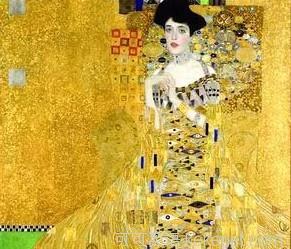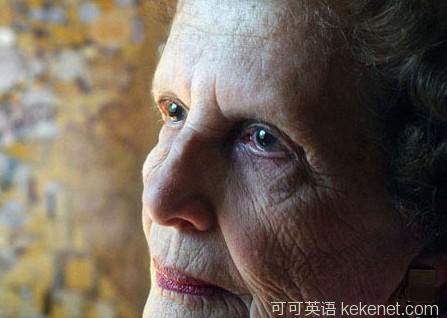
Obituary
Maria Altmann
Maria Altmann, pursuer of looted paintings, died on February 7th, aged 94

“Suffering” was the first word that came to Maria Altmann when she was asked about Aunt Adele Bloch-Bauer. Frail, dark, beautiful, always with a headache. Children annoyed her, because she had none of her own; small-talk made her furious, because she wanted to discuss religion and politics. (“My darling,” Mrs Altmann would sigh, “Adele was a modern woman living in the world of yesterday.”) Adele smoked like a chimney, and would drift around in loose white gowns with a gold cigarette-holder. Or she would sit, regal in black, holding court for musicians, artists and writers in the salon of her huge house just by the Vienna Staatsoper.
當人們向瑪麗亞·奧特曼(Maria Altmann)問及“姨媽阿黛爾·布洛赫-鮑爾(Adele Bloch-Bauer)”一事時,她說的第一句是“身心俱痛”。當年的阿黛爾有頭痛癥,脆弱、黝黑、美麗。孩子使阿黛爾煩惱,因為她自己沒有孩子。閑聊使阿黛爾狂怒,因為她想談論的是宗教和政治(瑪麗亞·奧特曼夫人這時會一聲嘆息:“親愛的,阿黛爾是一位生活于昔日塵世的現代女性”)。 阿黛爾吸煙,像個煙囪,而且,她會身著白色寬松長衣,帶著金制煙斗四處游逸。有時,她會一襲黑色的雍容華貴,坐在她那大宅的客廳里,引領音樂家、藝術家、作家們海闊天空。她那大宅剛好位于維也納國家歌劇院旁。
But the Adele the world came to know was as Gustav Klimt had painted her in 1907. It took him four years, longer than he spent on any other painting. He placed her in a swirling gown within a blaze of gold rectangles, spirals and Egyptian symbols from which she looked out in nervous loveliness, the epitome of Vienna's Golden Age. Her hands were strangely bent because, Mrs Altmann knew, she had a crippled finger, which she always tried to hide. She was also fairly sure that Aunt Adele and Klimt, with his satyr face and wild sexuality, had had a mad affair; her mother angrily denied it, said it had been just “an intellectual thing”, but you only had to look at her aunt's dark, languorous, faintly smiling eyes to think otherwise.
不過,世人最終熟悉阿黛爾是因于古斯塔夫·克里姆特(Gustav Klimt)于1907年為她作畫。克里姆特為她作畫耗去了四年時光,比他作的任何其它畫所花的時間都長。畫面上,克林姆特把阿黛勒包裹在長裙旋轉之中,四周用無數金光閃爍的長方、螺旋和埃及象征圖形點綴。在此背景下,她呈彌望狀,具有迷離的美感,成為維也納黃金時代的縮影。她的雙手奇怪地呈彎曲狀,奧特曼夫人知道,那是因為她有一根手指殘了,她總是想法掩住這一殘指。奧特曼也十分肯定,姨媽阿黛爾和體格強勁、性欲狂野的克里姆特曾有過一段火熱的私情;雖然奧特曼的母親憤怒地對此予以否認,說那只是“精神柏拉圖行為”,然而,你審視了她姨媽阿黛爾那雙黑色溫柔、隱含微笑的眼睛后,你會不得不生出別樣想法來。
“Golden Adele” haunted Mrs Altmann for the rest of her days. As a girl she led much the same “beautiful” life, dressed up in silk and organza, in a stately townhouse nearby, where artists and philosophers came and went to the sound of her father playing on a Stradivarius cello. After 1925, when Adele died at 43, the regular Sunday brunch at Uncle Ferdinand's would always include a viewing of the Klimt portrait, hung in Adele's bedroom in a sweet haze of fresh flowers. Four other Klimts also hung there. Three were landscapes: a beechwood, a dappled apple tree, houses by a river. The other was a later painting of Adele, pale and strained, standing in a big hat with her arms loose amid fauve colours of red, mauve and green.
《金色阿黛爾》使奧特曼夫人的晚年備受折磨。少女時,她過著與阿黛爾大致一樣的“美麗”生活——穿絲綢著輕紗,住在附近富麗堂皇的聯排別墅里,這是來來往往的藝術家和哲學家們聽她父親用斯特拉迪瓦里大提琴演奏音樂的地方。1925年,阿黛爾去世,43歲。之后,奧特曼姨父費迪南德家里的例行周日餐會總有一個內容是觀賞克里姆特肖像畫。畫被懸掛于阿黛爾的鮮花散發迷蒙的芳香臥室里。克里姆特的另四貼畫也懸掛在該室內,其中有三幅是風景畫,一幅是山毛舉林,一幅是斑紋蘋果樹,一幅是河邊房子。另一幅是關于阿黛爾后期的油畫,[畫中]阿黛爾顯得蒼白緊張、膀腕松弛,戴一大帽站立著,四周是紅、紫紅和綠色映襯。
All five paintings were stolen when the Nazis took Austria over in 1938. Mrs Altmann remembered the jubilation of the Anschluss, the church bells ringing; only the Jews wept. By then, she was just married to Fritz Altmann; and she sometimes wore, next to her skin, some of Adele's diamonds, which Uncle Ferdinand had given her as a wedding present. The Nazis stole them in short order, as they also seized Ferdinand's entire art collection, his delicate porcelain and his sugar refinery. “Portrait of Adele Bloch-Bauer I”, became the symbol of all that the family had lost.
1938年,德國納粹吞并奧地利,這五幅畫全被偷走。奧特曼夫人深深記得那伴著清脆教堂鐘聲,唯有猶太人在哭泣的德國納粹吞并奧地利的慶典。當時,她剛與弗里茨·阿爾特曼結婚;她有時還戴上阿黛爾的一些鉆石飾品,那是她姨父費迪南德作為結婚禮物送給她的。就像納粹奪走費迪南德的全部藝術畫、精美瓷器、制糖廠一樣,不久,納粹就把這些東西也偷走了。《阿黛爾·布洛赫-鮑爾夫人畫像I》成為這個家族失去一切的標志。
For many years—after she had fled to America with Fritz and made a new life in California, he working at Lockheed, she selling cashmere—Mrs Altmann supposed that the Klimt paintings had legitimately ended up in the Austrian National Gallery. But when the law changed in 1998, in favour of restitution, she vowed to get them back. The Austrian government refused. Adele's will, they said, had given the paintings to the gallery. And, they might have added, all Austria now thought it owned her golden, Klimtian beauty.
多年以來(這些年里,奧特曼與弗里茨一起逃離到了美國,并在加州開始了新生活,弗里茨在洛克希德公司工作,奧特曼出售羊絨毛),奧特曼夫人認為,克里姆特畫作已是合法地屬于奧地利國家美術館了。直到1998年,在法律作出了有利于物歸原主的修訂后,她才發誓要讓克里姆特畫作回到家族。奧地利政府拒絕歸還。奧府稱:阿黛爾遺囑已把這些畫作贈與了國家美術館。奧府還委婉補充到:現在,舉國上下,同此觀點:克里姆特畫中阿黛爾的金色之美屬于奧地利。
Battling in cashmere
Mrs Altmann went to war. At 82, in cashmere and silk scarves, she made an unlikely fighter. Her dress boutique in Cheviot Hills, where clients sat in her living room drinking Kaffee mit Schlag and nibbling on sausage, was probably the last vestige of a Viennese salon in the New World. Golden Adele, in paperweight form, lay on the coffee table and was rubbed hard for luck. But Mrs Altmann was all persistence, charm and energy—and the law was on her side.
奧特曼奔赴戰場了。八十有二的高齡,穿羊絨、披絲巾的裝束,使得奧夫人看起來不像一個真正的戰士。她在切維厄特街區經營的服飾精品店,或許是“新世界”的最后一家古典維也納沙龍,在這里,客戶們坐在客廳,品嘗奧式咖啡(Kaffee mit Schlag),細嚼香腸。咖啡桌上放著做成鎮紙石的“金色阿黛勒”, 為求訴訟順利,它被精心撫拭。奧特曼為爭取勝訴,投進了她全部的毅力、智慧和物力——而法律,也站在她這一邊。
Adele's will, as it turned out, only made a “kind request” to her husband to leave the paintings to the gallery. It was not binding, and in any case Mrs Altmann knew Adele's mind. She wanted the paintings left to the Vienna she knew, the vibrant, glittering, tolerant city of the early 20th century; not to a place from which all Jewish life had gone. She would never have felt at home there, as Mrs Altmann no longer did when she visited, defying security guards at the National Gallery to be photographed beside Aunt Adele, and saying loudly: “That painting belongs to me.”
阿黛爾的遺囑表達的原本意思,只是對其夫提過一個“意向性”的要求,把畫作留給藝術館,該遺囑并不具備法律約束力。再者,奧特曼清楚阿黛爾內心的真正意愿,那就是把畫作留給她生前親身體驗的一座城市,一座在20世紀初期充滿生機、燦爛輝煌、富于寬容的城市——維也納,而不是一個別的地方,一個所有猶太人的生命都已消失的地方。阿黛爾在這個地方絕不會有歸屬感,就像奧特曼自己回訪奧地利之后再也沒有歸屬感一樣。回訪時,奧夫人在國家美術館公開對抗安保人員的禁令,站在阿黛爾姨媽的肖像旁拍照,并大聲宣示:“那幅畫是我的!”
In 1999 she and her lawyer, Randol Schoenberg, tried to sue the Austrian government. When that proved too expensive, they argued as far as the Supreme Court that the case should be heard in America. They won; but then, in 2004, they went to independent arbitration. Three Austrian academics decided that the paintings should be returned. In 2006 Aunt Adele and the rest arrived with fanfare in Los Angeles: the largest single return, in monetary terms, of Nazi-looted art.
1999年,奧特曼和她的律師蘭多爾·勛伯格努力起訴奧地利政府。當發現起訴費用太昂貴后,他們據理爭取美國最高法院審理本案,結果遂愿。不過到了2004年后,他們轉而申請獨立仲裁。三位奧地利仲裁專家作出裁決:畫作應當退還。 2006年,“姨媽阿黛爾”肖像與另外幾幅畫在禮樂曲中抵達洛杉磯:這是納粹掠奪藝術品中單幅價值最高的回歸。
Only a few months later they were sold. All but one went away to private houses. The exception was Aunt Adele. She had always wanted her golden portrait in a public gallery, Mrs Altmann said, and so it was “beautiful” that Ronald Lauder, a businessman and philanthropist who had loved Adele's face from boyhood, instantly paid $135m to enshrine her in his Neue Galerie in Manhattan. Of course, she was too far away for many visits now. But Mrs Altmann could imagine her there, glowing and frail, wearing just the faintest aroma of those long-vanished cigarettes.
也就是僅僅數月之后,盡數拍賣了回歸的數畫。除了“姨媽阿黛爾”肖像,它們幾近都被藏之于私宅深院。奧特曼道:阿黛爾一直希望自己的金色肖像能展示于公共畫廊。此愿有了一個“美麗”的結局———自孩提時就喜愛阿黛爾芳容的商人、慈善家羅納德·勞德,在拍賣場立馬付費1.3億美元,把肖像買下,置于他在曼哈頓的畫廊(Neue Galerie),供若神明。雖然,而今要常常拜見阿黛爾的話,自然是太遠了點,但奧特曼尚能于此展開想像力,想像姨媽阿黛爾的熱情洋溢、脆弱嬌柔,想像從那已悵然遠去的煙草中散發的淡淡芳香……











